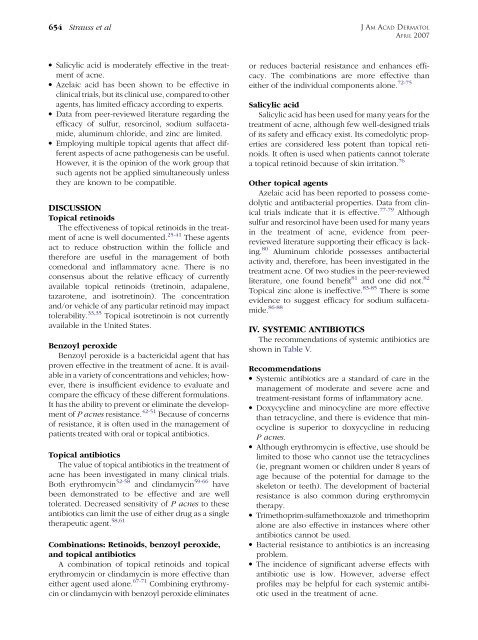Guidelines of care for acne vulgaris management
Guidelines of care for acne vulgaris management
Guidelines of care for acne vulgaris management
You also want an ePaper? Increase the reach of your titles
YUMPU automatically turns print PDFs into web optimized ePapers that Google loves.
654 Strauss et al<br />
JAM ACAD DERMATOL<br />
APRIL 2007<br />
d<br />
d<br />
d<br />
d<br />
Salicylic acid is moderately effective in the treatment<br />
<strong>of</strong> <strong>acne</strong>.<br />
Azelaic acid has been shown to be effective in<br />
clinical trials, but its clinical use, compared to other<br />
agents, has limited efficacy according to experts.<br />
Data from peer-reviewed literature regarding the<br />
efficacy <strong>of</strong> sulfur, resorcinol, sodium sulfacetamide,<br />
aluminum chloride, and zinc are limited.<br />
Employing multiple topical agents that affect different<br />
aspects <strong>of</strong> <strong>acne</strong> pathogenesis can be useful.<br />
However, it is the opinion <strong>of</strong> the work group that<br />
such agents not be applied simultaneously unless<br />
they are known to be compatible.<br />
DISCUSSION<br />
Topical retinoids<br />
The effectiveness <strong>of</strong> topical retinoids in the treatment<br />
<strong>of</strong> <strong>acne</strong> is well documented. 25-41 These agents<br />
act to reduce obstruction within the follicle and<br />
there<strong>for</strong>e are useful in the <strong>management</strong> <strong>of</strong> both<br />
comedonal and inflammatory <strong>acne</strong>. There is no<br />
consensus about the relative efficacy <strong>of</strong> currently<br />
available topical retinoids (tretinoin, adapalene,<br />
tazarotene, and isotretinoin). The concentration<br />
and/or vehicle <strong>of</strong> any particular retinoid may impact<br />
tolerability. 33,35 Topical isotretinoin is not currently<br />
available in the United States.<br />
Benzoyl peroxide<br />
Benzoyl peroxide is a bactericidal agent that has<br />
proven effective in the treatment <strong>of</strong> <strong>acne</strong>. It is available<br />
in a variety <strong>of</strong> concentrations and vehicles; however,<br />
there is insufficient evidence to evaluate and<br />
compare the efficacy <strong>of</strong> these different <strong>for</strong>mulations.<br />
It has the ability to prevent or eliminate the development<br />
<strong>of</strong> P <strong>acne</strong>s resistance. 42-51 Because <strong>of</strong> concerns<br />
<strong>of</strong> resistance, it is <strong>of</strong>ten used in the <strong>management</strong> <strong>of</strong><br />
patients treated with oral or topical antibiotics.<br />
Topical antibiotics<br />
The value <strong>of</strong> topical antibiotics in the treatment <strong>of</strong><br />
<strong>acne</strong> has been investigated in many clinical trials.<br />
Both erythromycin 52-58 and clindamycin 59-66 have<br />
been demonstrated to be effective and are well<br />
tolerated. Decreased sensitivity <strong>of</strong> P <strong>acne</strong>s to these<br />
antibiotics can limit the use <strong>of</strong> either drug as a single<br />
therapeutic agent. 58,61<br />
Combinations: Retinoids, benzoyl peroxide,<br />
and topical antibiotics<br />
A combination <strong>of</strong> topical retinoids and topical<br />
erythromycin or clindamycin is more effective than<br />
either agent used alone. 67-71 Combining erythromycin<br />
or clindamycin with benzoyl peroxide eliminates<br />
or reduces bacterial resistance and enhances efficacy.<br />
The combinations are more effective than<br />
either <strong>of</strong> the individual components alone. 72-75<br />
Salicylic acid<br />
Salicylic acid has been used <strong>for</strong> many years <strong>for</strong> the<br />
treatment <strong>of</strong> <strong>acne</strong>, although few well-designed trials<br />
<strong>of</strong> its safety and efficacy exist. Its comedolytic properties<br />
are considered less potent than topical retinoids.<br />
It <strong>of</strong>ten is used when patients cannot tolerate<br />
a topical retinoid because <strong>of</strong> skin irritation. 76<br />
Other topical agents<br />
Azelaic acid has been reported to possess comedolytic<br />
and antibacterial properties. Data from clinical<br />
trials indicate that it is effective. 77-79 Although<br />
sulfur and resorcinol have been used <strong>for</strong> many years<br />
in the treatment <strong>of</strong> <strong>acne</strong>, evidence from peerreviewed<br />
literature supporting their efficacy is lacking.<br />
80 Aluminum chloride possesses antibacterial<br />
activity and, there<strong>for</strong>e, has been investigated in the<br />
treatment <strong>acne</strong>. Of two studies in the peer-reviewed<br />
literature, one found benefit 81 and one did not. 82<br />
Topical zinc alone is ineffective. 83-85 There is some<br />
evidence to suggest efficacy <strong>for</strong> sodium sulfacetamide.<br />
86-88<br />
IV. SYSTEMIC ANTIBIOTICS<br />
The recommendations <strong>of</strong> systemic antibiotics are<br />
shown in Table V.<br />
Recommendations<br />
d Systemic antibiotics are a standard <strong>of</strong> <strong>care</strong> in the<br />
<strong>management</strong> <strong>of</strong> moderate and severe <strong>acne</strong> and<br />
treatment-resistant <strong>for</strong>ms <strong>of</strong> inflammatory <strong>acne</strong>.<br />
d Doxycycline and minocycline are more effective<br />
than tetracycline, and there is evidence that minocycline<br />
is superior to doxycycline in reducing<br />
P <strong>acne</strong>s.<br />
d Although erythromycin is effective, use should be<br />
limited to those who cannot use the tetracyclines<br />
(ie, pregnant women or children under 8 years <strong>of</strong><br />
age because <strong>of</strong> the potential <strong>for</strong> damage to the<br />
skeleton or teeth). The development <strong>of</strong> bacterial<br />
resistance is also common during erythromycin<br />
therapy.<br />
d Trimethoprim-sulfamethoxazole and trimethoprim<br />
alone are also effective in instances where other<br />
antibiotics cannot be used.<br />
d Bacterial resistance to antibiotics is an increasing<br />
problem.<br />
d The incidence <strong>of</strong> significant adverse effects with<br />
antibiotic use is low. However, adverse effect<br />
pr<strong>of</strong>iles may be helpful <strong>for</strong> each systemic antibiotic<br />
used in the treatment <strong>of</strong> <strong>acne</strong>.

















